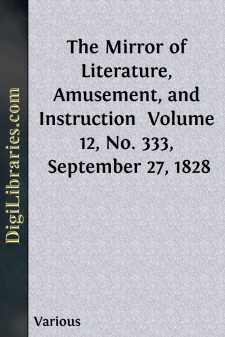Categories
- Antiques & Collectibles 13
- Architecture 36
- Art 48
- Bibles 22
- Biography & Autobiography 813
- Body, Mind & Spirit 142
- Business & Economics 28
- Children's Books 15
- Children's Fiction 12
- Computers 4
- Cooking 94
- Crafts & Hobbies 4
- Drama 346
- Education 46
- Family & Relationships 57
- Fiction 11828
- Games 19
- Gardening 17
- Health & Fitness 34
- History 1377
- House & Home 1
- Humor 147
- Juvenile Fiction 1873
- Juvenile Nonfiction 202
- Language Arts & Disciplines 88
- Law 16
- Literary Collections 686
- Literary Criticism 179
- Mathematics 13
- Medical 41
- Music 40
- Nature 179
- Non-Classifiable 1768
- Performing Arts 7
- Periodicals 1453
- Philosophy 64
- Photography 2
- Poetry 896
- Political Science 203
- Psychology 42
- Reference 154
- Religion 513
- Science 126
- Self-Help 84
- Social Science 81
- Sports & Recreation 34
- Study Aids 3
- Technology & Engineering 59
- Transportation 23
- Travel 463
- True Crime 29
The Mirror of Literature, Amusement, and Instruction Volume 12, No. 333, September 27, 1828
by: Various
Categories:
Description:
Excerpt
FIRE TOWER
Throughout Scotland and Ireland there are scattered great numbers of round towers, which have puzzled all antiquarians. They have of late obtained the general name of Fire Towers, and our engraving represents the view of one of them, at Brechin, in Scotland. It consists of sixty regular courses of hewn stone, of a brighter colour than the adjoining church. It is 85 feet high to the cornice, whence rises a low, spiral-pointed roof of stone, with three or four windows, and on the top a vane, making 15 feet more, in all 100 feet from the ground, and measuring 48 feet in external circumference.
Many of these towers in Ireland vary from 35 to 100 feet. One at Ardmore has fasciæ at the several stories, which all the rest both in Ireland and Scotland, seem to want, as well as stairs, having only abutments, whereon to rest timbers and ladders. Some have windows regularly disposed, others only at the top. Their situation with respect to the churches also varies. Some in Ireland stand 25 to 125 feet from the west end of the church. The tower at Brechin is included in the S.W. angle of the ancient cathedral, to which it communicates by a door.
There have been numerous discussions respecting the purposes for which these towers were built; they are generally adjoining to churches, whence they seem to be of a religious nature. Mr. Vallencey considers it as a settled point, that they were an appendage to the Druidical religion, and were, in fact, towers for the preservation of the sacred fire of the Druids or Magi. To this Mr. Gough, in his description of Brechin Tower, raises an insuperable objection. But they are certainly not belfries; and as no more probable conjecture has been made on their original purpose, they are still known as Fire Towers.
For this curious relic we are indebted to Mr. Godfrey Higgins's erudite quarto, entitled "The Celtic Druids," already alluded to at page 121 of our present volume.
BY A SEPTUAGENARIAN.
(For the Mirror.)(Stirbitch Fair, as our correspondent observes, was once the Leipsic or Frankfurt of England. He has appended to his "Account" a ground plan of the fair, which we regret we have not room to insert; the gaps or spaces in which, serve to show how much this commercial carnival (for such it might be termed) has deteriorated; for the remaining booths were built on the same site as during the former splendour of the fair. Our correspondent accounts for this "decay, by the facilities of roads and navigable canals for the conveyance of goods;" the shopkeepers, &c, "being able to get from London and the manufacturing districts, every article direct, at a small expense, the fair-keepers find no market for their goods, as heretofore." His paper is, however, a curious matter-of-fact description of Stirbitch, "sixty years since." We have been compelled to reject all but one verse of the "Chaunt," on account of some local allusions, the justice of which we do not deny, but which are scarcely delicate enough for our pages....












